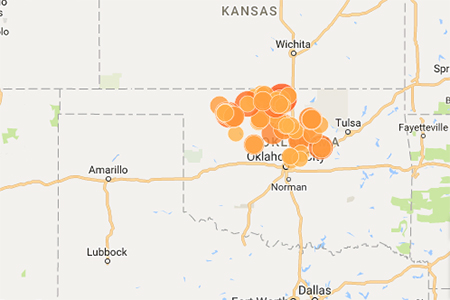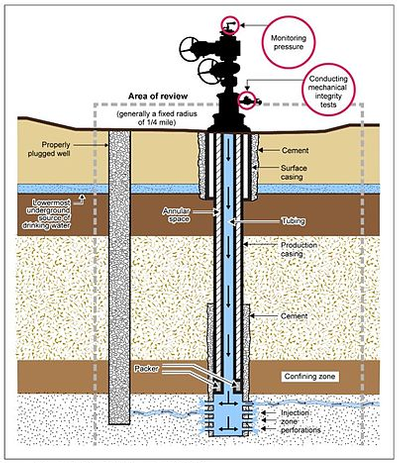FRIDAY, MAY 5, 2017
A group of seismologists says in a new report that disposal wells, particularly variable-rate wells, likely led to last September’s 5.8-magnitude earthquake near Pawnee, Oklahoma, the strongest quake ever recorded in the state.
The newest issue of the journal Seismological Research Letters, published by the Seismological Society of America, contains a special focus section on the Pawnee earthquake, which occurred Sept. 3. A number of articles explore the nature of the quake and its relationship to the injection of wastewater from oil and gas operations into disposal wells.
Oklahoma’s Quake Problem
Oklahoma experienced an uptick in seismic activity beginning in 2009. In the decades prior, the state saw about two earthquakes of magnitude 3.0 or greater each year, on average. In 2010, there were 41 such quakes in the state, and in 2015, the state’s most active year seismically, there were 903.

 |
| Courtesy of Oklahoma Geological Survey; map data © 2017 Google, INEGI |
|
USGS data indicates that there have been 78 quakes of magnitude 3.0 or greater in Oklahoma so far in 2017. |
The Pawnee quake, which occurred on the previously unidentified Sooner Lake fault, indicated that, while the frequency of seismic activity in Oklahoma had fallen off slightly in 2016, its intensity wasn’t decreasing. Three of the four strongest quakes since the uptick began in 2009 happened in 2016.
Experts speculate that the injection of the wastewater can “lubricate” fault lines and the pressurized fluid can induce movement in faults. Wastewater injection is often linked with hydrofracturing, the form of natural gas extraction that has become common over the past decade, but the practice can be a part of other forms of oil and natural gas extraction as well.
Seismologists refer to quakes that are likely triggered by human activity as “induced seismicity.” The U.S. Geological Survey first began specifically forecasting induced seismicity based on wastewater injection last year.
Disposal Rate Study
In one article in the new journal issue, three seismologists from the USGS look specifically at variable-rate and constant-rate wells. The authors note that “it may have been the variable-rate wells that were most important in the Pawnee event,” according to the SSA.
 |
| U.S. Government Accountability Office |
|
Experts speculate that the injection of the wastewater can “lubricate” fault lines and the pressurized fluid can induce movement in faults. |
Using simulation models, the scientists noted that variable-rate injection seemed to predict greater seismicity, though they also say the gradual loading from constant-rate wells in the area likely primed the fault for the quake.
The Role of the Arbuckle
In another article, Kayla Kroll, of Lawrence Livermore National Laboratory, along with two co-authors, looks at changes in two monitoring wells in the Arbuckle formation, a rock layer beneath the oil- and gas-producing layers in the region. Arbuckle rock is thought to be “under-pressured,” accepting water easily, and has therefore been linked with induced seismicity.
Kroll’s research looks at levels in the monitoring wells around the Pawnee quake and another recent seismic event, the Nov. 7 quake near Cushing, which registered a magnitude of 5.0. The research team says the results “may indicate that dynamic shaking resulted in physical alteration of the Arbuckle at distances up to [about] 50 [kilometers] from the Pawnee earthquake.”
Injection Site Shutdowns
The Oklahoma Corporation Commission ordered the suspension of 37 Class II injection sites in the state immediately after the Pawnee earthquake, and the U.S. Environmental Protection Agency shut down 17 more in the subsequent week. Hundreds of other injection sites had been shut down earlier in 2016, and lowering oil prices led to a decrease in the overall number of injection wells around the same time. The decrease in wells coincided with a drop in the rate of quakes, leading some to speculate about the correlation between the two.
USGS data indicates that there have been 78 quakes of magnitude 3.0 or greater in Oklahoma so far in 2017 as of May 4; that puts the state on pace for about 230 total this year, which would continue the downward trend in terms of frequency of seismic activity.
Tagged categories: Environmental Protection; Oil and Gas; Program/Project Management